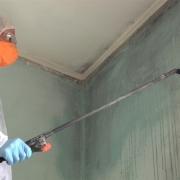What Happens During Mold Remediation?
When a mold problem is detected, it is important to hire a company to do the remediation. This will ensure that the mold is removed completely and that it won’t return.
Remediation involves sealing off the affected area by closing all doors and windows, using duct tape to seal plastic sheeting, and exhausting air from the outside through a fan. This will prevent the spread of spores to unaffected areas.
Cleaning
During cleaning, mold remediation technicians disinfect the area and dispose of infected materials. They also apply solutions that kill remaining spores and prevent future growth.
The cleaning process starts with sealing the affected areas to reduce the likelihood that mold spores will spread throughout your home and cause more damage. Then, a wet/dry vacuum is used to clean the affected materials and contaminated air is sucked outside.
Wearing protective gear and a mask is recommended, but not always necessary. Spraying a moldy area with a solution of water and bleach will get rid of surface mold, but spores stay in the air.
Spores can be difficult to remove, even with professional help. A professional may use a combination of HEPA-rated vacuums, air purifiers and wet wipers.
Removal
During mold removal, professionals must isolate the area where mold is growing to keep mold spores from spreading. They do this by sealing windows and doors, and covering affected areas with plastic sheeting.
They then spray the affected area with biocide, which kills mold and prevents it from re-growing. Next, they clean all non-porous surfaces to remove spores and excess water.
Once this is complete, they dry all materials that were affected. Depending on the severity of the problem, this may include drywall, carpet, insulation, or even furniture.
The remediation professionals will also re-seal the damaged areas so that mold cannot grow again. This is a vital step, as it ensures that everyone living in the home is safe.
Once the cleanup is completed, the mold removal professionals will begin to clean up and restore the home. This may include retiling floors, replacing damaged items, or restoring upholstery and fabrics.
Disposal
During mold remediation, building materials like drywall and insulation that have mold on them are disposed of. They are carefully packaged in double-bagged air-tight bags and carried out accordingly.
The remediation team then sanitizes the contaminated areas using disinfectants that kill any remaining spores. This is done to protect occupants from any health risks.
To make the job safe, technicians wear protective gear like boots and goggles. This is to prevent inhaling spores that can cause serious respiratory illnesses and even fatality.
Next, the contaminated area is isolated from the rest of the home to ensure that it does not spread. Technicians use plastic sheeting to cordon off the area for safety.
During this process, technicians dry the contaminated area as quickly as possible. This can include setting up industrial fans and dehumidifiers.
Remediation
If a professional is able to pinpoint the location and scope of mold contamination, the remediation process starts. This involves identifying the source of moisture, and repairing any water or moisture issues to prevent further growth.
During this step, technicians will also check for other possible problems in the building that can cause additional mold growth. These include leaking pipes, flooding, groundwater intrusion, and poor ventilation.
Once they know where the mold is growing, they will start scrubbing affected areas. These surfaces can include drywall, carpet, insulation and wood trim.
They’ll use biocide, an EPA-approved mold killer, to make the area sterile, which will prevent the mold from reproducing.
Next, the team will clean any non-porous surfaces with HEPA-approved vacuums. This ensures that any spores that escaped during the previous steps are killed.
After the removal and cleaning processes are complete, the restoration company will begin restoring any contents that were salvageable. This may involve packing up furniture, electronics, and other belongings and taking them off site for repair.






